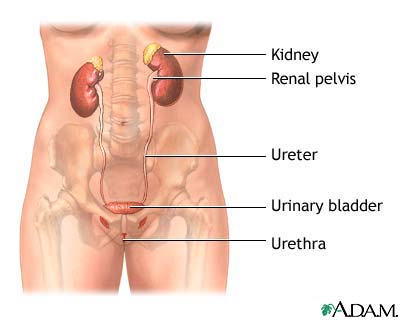Treatment
In children, UTIs should be treated quickly with antibiotics to protect the developing kidneys. Any child under 6 months old or who has other complications should see a specialist immediately.
Younger infants will usually stay in the hospital and be given antibiotics through a vein. Older infants and children are treated with antibiotics by mouth. If this is not possible, they are admitted to the hospital where they are given antibiotics through a vein.
It is important that your child drink plenty of fluids during the time they have a urinary tract infection.
Some children may be treated with antibiotics for long periods of time (as long as 6 months – 2 years), or they may be prescribed stronger antibiotics.
The health care provider may also recommend low-dose antibiotics after the first symptoms have gone away. This type of treatment is less common now than it once was.
Antibiotics commonly used in children include:
- Amoxicillin or amoxicillin/clavulanic acid (Augmentin)
- Cephalosporins
- Doxycycline (should not be used in children under age 8)
- Nitrofurantoin
- Trimethoprim-sulfamethoxazole
Follow-up urine cultures may be needed to make sure that bacteria are no longer in the bladder.
Prognosis (Expectations)
Most children are cured with proper treatment. The treatment may continue over a long period of time.
The long-term consequences of repeated UTIs in children can be serious. However, these infections can usually be prevented.
Complications
- High blood pressure
- Kidney abscess
- Kidney infection (pyelonephritis)
- Renal insufficiency or kidney failure
- Swelling of the kidneys (hydronephrosis)
Calling Your Health Care Provider
Call for an appointment with your health care provider if your child’s UTI symptoms continue after treatment or come back more than twice in 6 months.
Call your health care provider if the child’s symptoms get worse, or new symptoms develop, especially:
- Back pain or flank pain
- Bad-smelling, bloody, or discolored urine
- Fever of 100.4°Fahrenheit (38°Celcius) rectally in infants, or over 101°Fahrenheit (38.3°Celcius) in children
- Low-back pain or abdominal pain (especially below the belly button)
- Persistent fever
- Unusually frequent urination or frequent urination during the night
- Vomiting
Prevention
- Avoid giving your child bubble baths
- Have your child wear loose-fitting underpants and clothing
- Increase your child’s intake of fluids
- Keep your child’s genital area clean to prevent bacteria from entering through the urethra
- Teach your child to go the bathroom several times every day
- Teach your child to wipe the genital area from front to back to reduce the chance of spreading bacteria from the anus to the urethra
Long-term use of preventive (prophylactic) antibiotics may be recommended for some children who are prone to chronic UTIs.
Pictures & Images
Female urinary tract
-
Urinary tract infection – children: Overview, Causes
-
Urinary tract infection – children: Symptoms & Signs, Diagnosis & Tests
-
Urinary tract infection – children: Treatment
Review Date : 10/3/2009
Reviewed By : Neil K. Kaneshiro, MD, MHA, Clinical Assistant Professor of Pediatrics, University of Washington School of Medicine. Also reviewed by David Zieve, MD, MHA, Medical Director, A.D.A.M., Inc.
![]()
